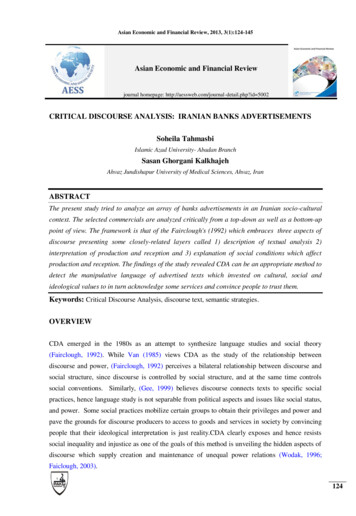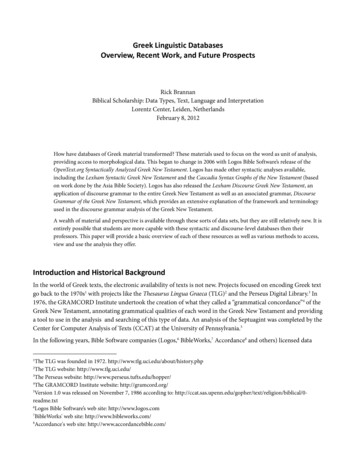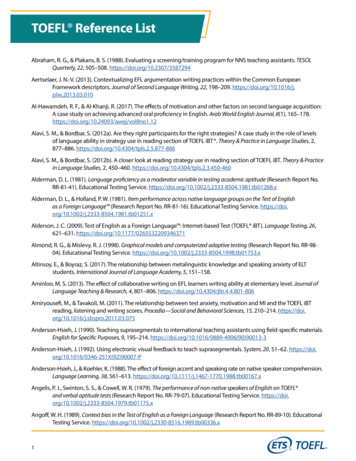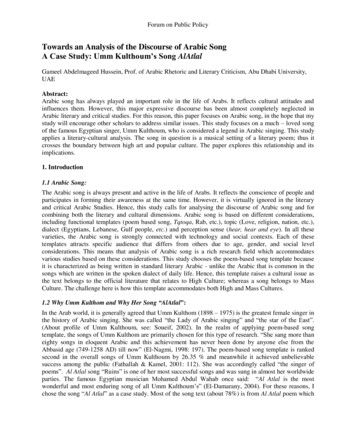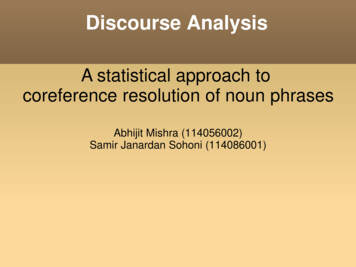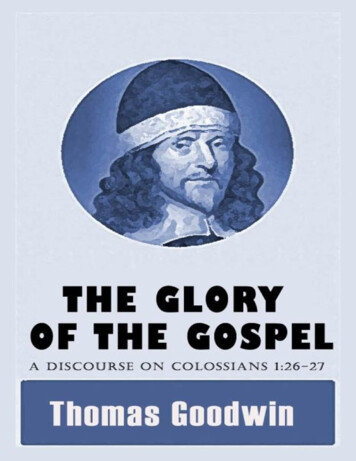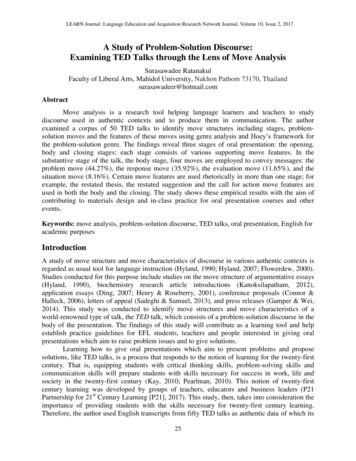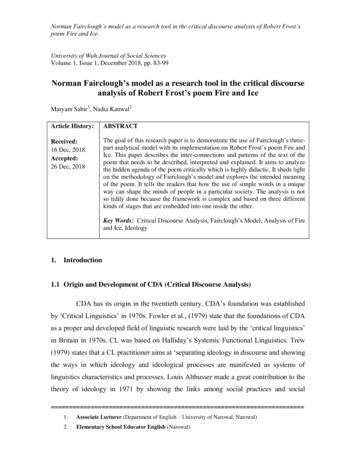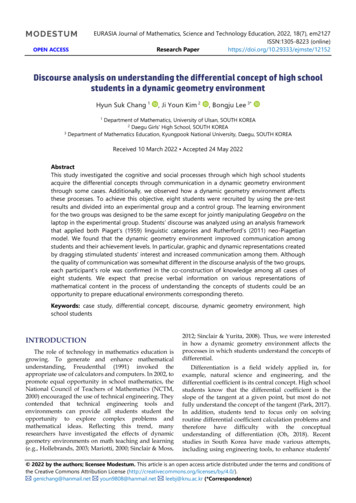
Transcription
OPEN ACCESSEURASIA Journal of Mathematics, Science and Technology Education, 2022, 18(7), em2127ISSN:1305-8223 (online)Research e analysis on understanding the differential concept of high schoolstudents in a dynamic geometry environmentHyun Suk Chang 1, Ji Youn Kim 2, Bongju Lee 3*Department of Mathematics, University of Ulsan, SOUTH KOREA2 Daegu Girls' High School, SOUTH KOREA3 Department of Mathematics Education, Kyungpook National University, Daegu, SOUTH KOREA1Received 10 March 2022 Accepted 24 May 2022AbstractThis study investigated the cognitive and social processes through which high school studentsacquire the differential concepts through communication in a dynamic geometry environmentthrough some cases. Additionally, we observed how a dynamic geometry environment affectsthese processes. To achieve this objective, eight students were recruited by using the pre-testresults and divided into an experimental group and a control group. The learning environmentfor the two groups was designed to be the same except for jointly manipulating Geogebra on thelaptop in the experimental group. Students’ discourse was analyzed using an analysis frameworkthat applied both Piaget’s (1959) linguistic categories and Rutherford’s (2011) neo-Piagetianmodel. We found that the dynamic geometry environment improved communication amongstudents and their achievement levels. In particular, graphic and dynamic representations createdby dragging stimulated students’ interest and increased communication among them. Althoughthe quality of communication was somewhat different in the discourse analysis of the two groups,each participant’s role was confirmed in the co-construction of knowledge among all cases ofeight students. We expect that precise verbal information on various representations ofmathematical content in the process of understanding the concepts of students could be anopportunity to prepare educational environments corresponding thereto.Keywords: case study, differential concept, discourse, dynamic geometry environment, highschool studentsINTRODUCTIONThe role of technology in mathematics education isgrowing. To generate and enhance mathematicalunderstanding, Freudenthal (1991) invoked theappropriate use of calculators and computers. In 2002, topromote equal opportunity in school mathematics, theNational Council of Teachers of Mathematics (NCTM,2000) encouraged the use of technical engineering. Theycontended that technical engineering tools andenvironments can provide all students student theopportunity to explore complex problems andmathematical ideas. Reflecting this trend, manyresearchers have investigated the effects of dynamicgeometry environments on math teaching and learning(e.g., Hollebrands, 2003; Mariotti, 2000; Sinclair & Moss,2012; Sinclair & Yurita, 2008). Thus, we were interestedin how a dynamic geometry environment affects theprocesses in which students understand the concepts ofdifferential.Differentiation is a field widely applied in, forexample, natural science and engineering, and thedifferential coefficient is its central concept. High schoolstudents know that the differential coefficient is theslope of the tangent at a given point, but most do notfully understand the concept of the tangent (Park, 2017).In addition, students tend to focus only on solvingroutine differential coefficient calculation problems andtherefore have difficulty with the conceptualunderstanding of differentiation (Oh, 2018). Recentstudies in South Korea have made various attempts,including using engineering tools, to enhance students’ 2022 by the authors; licensee Modestum. This article is an open access article distributed under the terms and conditions ofthe Creative Commons Attribution License kr (*Correspondence)
Chang et al. / Discourse on understanding a differential concept in a dynamic environmentContribution to the literature This study tried to explore the cognitive and social processes through which high school students acquirethe differential concepts through communication in a dynamic geometry environment.This study shows how a dynamic geometry environment affects cognitive and social processes.This study considered rationale for the applicability of Piaget’s (1959) speech category and Rutherford’s(2011) neo-Piagetian model and applied the language analysis framework that applied two modelstogether.understanding of the differential concept (e.g., Hwang &Kim, 2016; Kang, 2012; Lee et al., 2014; Oh, 2018).However, according to our review of the literature,studies have rarely investigated how a dynamicgeometry environment affects students’ communicationin the learning process to understand differentialconcepts. This gap in the literature encouraged us toconduct a study on our topic of interest, and we tooknote of Sfard’s (2007) discourse theory for the analysis ofcommunication that occurs in a class.understand the concepts of differential? To solve theseproblems, we considered the rationale for theapplicability of Piaget’s (1959) speech category andRutherford’s (2011) neo-Piagetian model and applied thelanguage analysis framework that applied two modelstogether.Many studies have demonstrated that Sfard’s (2007)discourse theory can be applied in mathematicseducation (e.g., Gucler, 2013; Kim et al., 2012; Lewis,2017; Sinclair & Moss, 2012; Sinclair & Yurita, 2008). Thefocus of this discourse theory is the analysis of theprocess by which students’ colloquial discourses aretransformed into mathematical discourses. However,some studies related to this theory have not presented aframework for analyzing students’ language in thecourse of teaching and learning. To fill this gap in theliterature, Sinclair and Moss (2012) analyzed the levelspecific language discourse by applying Van Hieles’theory of geometry levels, and Kim et al. (2012)developed structured questionnaires to classify the levelof infinite concept.Piaget (1959) classified the external expression ofchildren’s speech into two types, namely, egocentricspeech and socialized speech, depending on whether thelistener’s perspective is considered. He categorizedegocentric speech into repetition, monologue, and dualor collective monologue and socialized speech intoadapted information, criticism, command-requestthreat, question, and answer. In this functionalclassification of children’s speech, the branching point ofthe categorization of egocentric speech and socializedspeech is a dual or collective monologue and adaptedinformation. A dual or collective monologue is animmediate response to external stimuli, withoutunderstanding or participation, and does not considerthe perspectives of others. For example, when a childappears to be talking but only asserts oneself and theconversation is disconnected. Adapted informationcorresponds to a case of exchanging thoughts withothers, conveying interests, affecting behavior, andcooperating for a common purpose. From this point on,children begin to consider others’ perspectives, and theirlanguage is socialized.In this context, two studies, Piaget (1959) andVygotsky (1987), of the relationships between thoughtand language are noteworthy. Devries (1997) positedthat Piaget’s (1959) theory could be fused withVygotsky’s (1987) theory through the social expansion ofchild research. Rutherford (2011) proposed a neoPiagetian model that extended Piaget’s (1959) cognitiveperspective to a socio-cultural perspective in the humansocialization process. In addition, researchers havehighlighted the need for empirical studies on thecognitive and social dimensions of students’ knowledgeconstruction and their interaction patterns andinfluences (e.g., Bormanaki & Khoshhal, 2017).In this study, we intended to analyze the discourse ofhigh school students understanding the concepts ofdifferential in a dynamic geometry environment. Thefollowing two problems were set for discourse analysis.First, how are the cognitive and social processes in whichhigh school students acquire differential conceptsthrough communication in a dynamic geometryenvironment? Second, how does a dynamic geometryenvironment affect the processes by which students2 / 14THEORETICAL BACKGROUNDPiaget’s Speech CategoryMayer (2005) described Piaget (1959) as the first torecord and analyze children’s peer conversations withinan established social context. Mayer (2005) viewed thatPiaget (1959) attempted to interpret children’s speechfunction in relation to the accompanying behavior,rather than the mere feature of children’s utteredphrases. In other words, Mayer (2005) explained thatPiaget (1959) introduced the natural scientists’ methodto the study of children’s behavior and language andadapted it to that purpose. Vygotsky (1987) suggestedthat the greatest strength of Piaget’s (1959) theory is itsbasis on an evolutionary perspective and pureempiricism and proposed that the factual basis ofPiaget’s (1959) theory was presented in studies ofchildren’s use of language.
EURASIA J Math Sci Tech Ed, 2022, 18(7), em2127Based on this background, in this study, we appliedthe natural scientific and measurable functionalclassification of children’s speech, the basis of Piaget’s(1959) theory, to discourse analysis.Rutherford’s Neo-Piagetian ModelVarious attempts have been made to apply Piaget’s(1959) theory to teaching and learning. Rutherford(2011)’s neo-Piagetian model is one of these studies. Aprerequisite for these attempts is the consideration ofsocial relations, that is, socio-cultural context.Rutherford (2011) constructed a theory of assimilationand accommodation in the cognitive and culturaldomain (Bormanaki & Khoshhal, 2017). Bormanaki andKhoshhal (2017) considered that in addition to thecognitive development of the ego, contextual and sociocultural factors play a notable role in cognitivedevelopment. They viewed foreign language learning,especially reading comprehension, as related tocontextual and socio-cultural factors. For example, whenreaders read text related to English literature, theyunderstand the text well if they are familiar with theculture and social context of the English-speaking world.In this case, readers can assimilate and accommodate thecultural information in the text, achieve culturalequilibration, and further their cognitive development.Thus, Bormanaki and Khoshhal (2017) proposed the neoPiagetian model as a theory that could play an importantrole in the field of teaching and language learning.Rutherford (2011) explained the process of anindividual’s adaptation and adjustment to society ascognitive social assimilation and cognitive socialaccommodation based on Piaget’s (1959) theory ofassimilation and accommodation. Rutherford (2011)defined cognitive assimilation as the growth of theschema for the adaptation of the internal system,cognitive accommodation as the change of the schema forexternal (environmental) adaptation, social assimilationas the cultural growth through adaptation of variouscultural groups for adaptation in context, and socialaccommodation as the cultural change for adaptation ofbeliefs and traditional practices of various culturalgroups. Thus, the model proposed by Rutherford (2011)is that an individual’s personality develops throughcognitive assimilation, cognitive accommodation, socialassimilation, and social accommodation throughlinguistic semiotic mediation between ommunication is possible by using the symbol oflanguage in society and that the social ego is formedthrough this use. Thus, in this study, we considered thatRutherford’s (2011) neo-Piagetian model might reveal inthe communication process the cognitive aspects ofstudents’ changes in mathematical concepts and themeaning of social interaction or context.Table 1. Framework for students’ language analysisCategoryCodePiaget’s Egocentric RepetitionRspeech speechMonologueMDual monologueDMSocialized Adapted atCTQuestionQAnswerANeoCognitive assimilationNCAPiagetian Cognitive accommodationNCRmodelSocio-cultural assimilationNSASocio-cultural accommodationNSRMETHODSFramework and Perspectives for Students’ LanguageAnalysisThe primary interest of this study was to assess inwhat language format students express their thoughtchanges such as assimilation and accommodation on thedifferential concepts in a dynamic geometryenvironment. We attempted to use an analysisframework that applied both Piaget’s (1959) speechcategory and Rutherford’s (2011) neo-Piagetian model,to analyze the language in students’ discourses (Table1). We coded the eight categories of Piaget’s (1959)speech and the four dimensions of the neo-Piagetianmodel in Table 1.Notably, assuming that there is a limit to findingverbal evidence of assimilation and accommodation, thefollowing four perspectives were noted. First, weattempted to explain the concept of understanding aprocess of an individual or collective by assimilation andaccommodation. In particular, in the process ofunderstanding a concept by a student, we regarded it tobe socio-cultural if he/she was absorbed into culturethrough cooperation or agreement with others, forexample, a teacher or fellow students. Second, verbalevidence of assimilation and accommodation weredesignated as “grow” and “change,” respectively, basedon Rutherford (2011). However, the distinction betweenassimilation and accommodation might be ambiguous,and the linguistic expressions of students that resultfrom assimilation and accommodation might notmanifest. Assuming that all events presuppose a changein thinking, on the basis of the overall context ofdiscourse, we attempted to classify each event intoassimilation and accommodation. Third, because thesame word could have different meanings or a differentword could have the same meaning, we observed andclassified the language expression of each student.Fourth, we reclassified Piaget’s (1959) speech categoriesinto four dimensions in the neo-Piagetian model.3 / 14
Chang et al. / Discourse on understanding a differential concept in a dynamic environmentTable 2. Class topics and environmentGroupEnvironmentExperiment Cooperative learning through tasks with Geogebra without ateacherControlCooperative learning through tasks without a teacherThe advantages of the language analysis frameworkin Table 1 to which both theories are applied aresummarized in the following three points. First, inPiaget’s (1928) language category, egocentric speakingwas mainly used by Piaget (1959) to show that children’segocentric speaking decreases in the process oftransitioning from the pre-operational stage to theconcrete operational stage, but we regarded AI, A, CR,etc., as linguistic tools that play a role in communication.This is because AI, A, CR, etc., implies that the studentconsiders the intentions of others or conveys his/herown intention. Thus, in this study, AI, A, CR, etc., wereused to analyze quantitative and qualitative changes inpractical communication. Second, although Piaget’s(1959) speech category considered only the aspect ofsubjective socialization in which students consider eachother, Rutherford (2011)’s classification of cognitive odation made it possible to express thesociological influence on the students in every languagecategory. It can be seen as a further expansion of thescope of analysis of the Piaget’s (1959) speech category.Third, the language analysis framework in Table 1 wasable to show concretely the case in which studentsacquired the geometric meaning (the slope of the tangentline) of the differential (instantaneous rate of change) inthe dynamic geometric environment.A few of examples of the language analysisframework applied in this study are as follows. First, thestudent C2 who said “if you get 𝑓′(𝑥) first, you get 2𝑥 3” is presenting the result related to the derivative of thefunction and giving the information to other students.This student’s language was classified as AI that conveysmath-related information to other students. At the sametime, in this process, the student recalled the concept ofdifferentiation and applied it to the function, so it wasclassified as NCA.Let’s apply it to another example: “When this point isnear to this point, it is tangent. Is this (2, 1)? Then, when(4, 7) approaches (2, 1), the slope of the tangent becomesequal. (4, 7) overlaps with (2, 1) and this line overlapswith the tangent”. Student E3, who said this, looked atthe computer and visually recognized the process ofchanging the graph from the average rate of change tothe instantaneous rate of change, and subjectivelyunderstood the geometric meaning of the instantaneousrate of change. And she shared the knowledge she hadacquired to other students, so we classified this languageas AI. At the same time, we judged that the studentchanged the concept of instantaneous rate of change bysubjective judgment based on dynamic graph expression4 / 14Topics Average rate of change Differential coefficient DerivativeTime (min)40rather than logically expanding the concept ofdifferentiation, and we reclassified this verbalexpression as NCR. On the other hand, since thesestudents’ conceptual images were formed based ondynamic visual images rather than a formal definition ofdifferentiation, it implies the occurrence ofmisconceptions related to the differential concept in thefuture. Nevertheless, we interpreted the dynamic graphrepresentation as affecting students’ understanding ofthe concept of differentiation.Class Topics and EnvironmentIn mid-October 2018, we separated eight participantsinto two groups of four and then conducted theexperiment. Each class was held for 40 minutes for eachgroup. Both groups conducted classes that completedthe same tasks, without an explanation or interventionfrom a teacher (Table 2).In the experimental group class, studentsmanipulated Geogebra by jointly using one laptop. Theyhad experience using cell-phones to draw graphs in theirfirst-year math classes; thus, they did not object to usingGeogebra and had no difficulty manipulating it. Toexclude the overlapping phenomenon of students’change by a teacher and students’ change by usingGeogebra, and to reveal the effects of Geogebra, the teacherdid not intervene in the cooperative learning process andmerely observed the students. Geogebra’s features relatedto dragging and dynamic graph representation arecommon features of other dynamic geometry programs.Therefore, in this study, Geogebra, a geometric dynamicsoftware familiar to students, was used.Test ToolWe used six questions to evaluate how well studentsunderstood three class topics (Table 3). Two problemswere presented per topic. One problem in each topic waseasily solved by calculation, and the other problemrequired simple application ability. We extracted the sixproblems from a calculus I textbook. The pre- and posttest tools comprised the same problems. We assessedthat the pre-test did not affect the post-test becausestudents who insufficiently understood differentialconcepts were selected and the post-test was conductedapproximately one month after the pre-test. In addition,the interviews indicated that the students did notrecognize the pre-test and post-test problems as thesame.
EURASIA J Math Sci Tech Ed, 2022, 18(7), em2127Table 3. Test toolTopicsAverage rate of changeDifferential coefficient orinstantaneous rate of changeDerivative functionProblems1. In the following function 𝑓(𝑥) 𝑥 2 𝑥, calculate the average rate of change when thevalue of 𝑥 changes from 1 to 3.2. For a function 𝑓(𝑥) 𝑥 2 3𝑥, the average rate of change is 0 when the value of 𝑥changes from 𝑎 to 𝑎 2, then calculate value of the constant 𝑎.3. Calculate the differential coefficient at 𝑥 1 in the function 𝑓(𝑥) 𝑥 2 𝑥 1.4. For a function 𝑓(𝑥), obtain the extreme values of limℎ 0𝑓(1 5ℎ) 𝑓(1)ℎwhen 𝑓(1) 5.5. Use definition of a derivative function to find derivative of function f(x) 𝑥 4 .6. Find the rest of the polynomial 𝑥 7 𝑥 3 3 divided by (𝑥 1)2 .ParticipantsTo select participants, we conducted a pre-test with100 high school sophomores in D-city, South Korea, whohad learned differential concepts in September 2018. Onthe basis of the test results, we first selected studentswho required additional learning on the differentialconcept; next, eight students who wanted to voluntarilyparticipate in the experiment were finally selected. Allthe students provided information on their grades,tendencies, and attitudes toward math, and their mathteachers provided information on the students’communication abilities. On the basis of thisinformation, we divided students into an experimentalgroup and a control group, each comprising fourstudents at similar levels in every aspect.The profiles of the four students in the experimentalgroup are as follows. E1 was a high-achieving student.She generally enjoyed studying math, and her scoreswere higher in math than in other subjects. She wasintrovert but kindly answered her friends’ questions onproblems that they did not understand. E2 was arelatively high-achieving student. She was usually quietbut did her best to participate. She had low confidencein math; thus, she carefully studied and often asked herfriend questions. She solved the textbook problemsseveral times and studied hard enough so that she couldsolve every problem in the textbook before theexamination. E3 was a mid-achieving student. Sheencouraged and led her friends effectively as the leaderof her class. She did not like math but wanted to be goodat it. E4 was a relatively low-achieving student. Sheactively participated in class but did not study mathmuch. Her math grades were lower than those of othersubjects. She had poor comprehension ability butattempted to ask questions and understand the answers.The profiles of the students in the control group areas follows. C1 was a high-achieving student. She had ated in class. She also effectively shared what sheunderstood with her friends. She thought that her scoresin math were lower than those in other subjects; thus, sheinvested in studying math. C2 was a relatively highachieving student. She was sincere, diligent, andhardworking. She liked math and had higher scores inmath than in other subjects. She was introvert butanswered her friends kindly if they asked aboutproblems. C3 was a mid-achieving student. She was anactive class leader and got along well with her friends.She did not like math and did not ordinarily study math.C4 was a relatively low-achieving student at school. Sheliked to hang out with friends and wanted to be good atmath but was not. Although she participated actively inclass and understood concepts when they wereintroduced, because she did not subsequently review theconcepts, she forgot them.In terms of communication, we compared the twogroups and expected them to show similarcommunication patterns as follows. In the experimentalgroup, E3 would take a leading role in the dialog becauseshe effectively led students. E1 and E2 had high grades;thus, they would mainly discuss and answer theirfriends’ questions. E4 would continue her group’sconversation by asking about what she did notunderstand. In the control group, C3 would lead theconversation because she was an excellent class leader.C1 and C2 would comment on or explain the learningcontent because they had high grades. C4 usuallyparticipated in class and expressed her opinions; thus, ifshe did not understand, she would ask her friendquestions and encourage them to provide explanations.Task MaterialThe task material comprised three parts—averagerate of change, instantaneous rate of change, andderivative concepts—based on a calculus I textbook. Thetask for the average rate of change was organized intothree subtasks:1. indicating the change in 𝑥 and 𝑦 as symbols,2. defining the average rate of change, and3. solving basic examples.The task for the instantaneous rate of change wasorganized into three subtasks:1. defining the instantaneous rate of change or thedifferential coefficient at a point,2. understanding its geometry meaning throughgraphs, and3. solving basic examples.The task for derivative concepts comprised twosubtasks:5 / 14
Chang et al. / Discourse on understanding a differential concept in a dynamic environmentTable 4. Frequency by language categoryExperimental 4842Total1136225171441234511. defining the concept of derivative and2. solving basic examples.In the case of subtasks that define and explainmathematical concepts, we left blanks so that thestudents directly filled in the formulas, terminologies,and symbols. For the example subtasks, only theproblems were presented, and the students were askedto solve them.Data Collection and AnalysisAll classes were recorded by camcorder, with theconsent of the students, and transcribed. The transcriptincluded various verbal expressions that could revealstudents’ behavior, attitudes, and feelings. Individualinterviews were conducted with all four students in theexperimental group, and interviews in the control groupwere conducted only when confirmation was required.Individual interviews were recorded and the recordingstranscribed after receiving students’ consent. In theinterviews with the experimental group, we askedstudents whether Geogebra and cooperative learningwere helpful. The purpose of these questions was toassess whether students’ understanding of differentialconcepts changed and they encountered any difficultieswhile communicating with each other. We alsoattempted to determine students’ perspectives oflearning using Geogebra. Students’ language expressions6 / 14-211344569161C11136710735C21214614Control 1112727194122107in the transcript were coded based on the framework inTable 1 and four perspectives in the analysis. Based onthe coded data, we calculated the categorical frequencyof each student’s language. We examined languagefrequency and class scenes to assess how students’understanding of differential concepts changed.Triangulation verification was conducted by discussingthe data in the process of analysis.RESULTS AND DISCUSSIONAnalysis by Language CategoryTable 4 presents our classification results of eightstudents’ speech expressed during their cooperativelearning, extracting speech only related to differentialconcepts. Comparing the discourse between theexperimental group and the control group, we identifiedfour characteristics of communication. First, the totalspeech frequency of the experimental group (161) wasapproximately 50% more than that of the control group(107). This finding demonstrates that students’ classparticipation increased in a dynamic geometryenvironment where the teacher’s intervention wasexcluded. Second, the ratio of speech categories, AI, Q,and A, to actual communication functions was 92% inthe experimental group and 74% in the control group. Inaddition, the speech frequency of NSA and NSRmeaning cooperation or agreement with others was 64 in
EURASIA J Math Sci Tech Ed, 2022, 18(7), em2127the experimental group and 46 in the control group.These results show that the interaction among studentsin the dynamic geometry environment generated morethan in an environment that did not. Third, in bothgroups, students’ speech corresponding to CR and CTwas not observed. This finding reveals that moststudents avoided words or actions that threaten theirpeers with criticism or commands during cooperativelearning. Fourth, for the control group, no commodation that indicated students’ changes; in theexperimental group, we observed five correspondingpieces of evidence. The biggest difference between thetwo groups was to use Geogebra; thus, we interpreted thisresult to be due to environment in which rich visualmediators can be used. The evidence for thisinterpretation is presented in detail in class scenes.We now examine the two groups’ speechcharacteristics in detail. In the experimental group class,there were 175 speech states by students, 161 of whichrelated to differential concepts. Table 4 highlights threenotable findings for the experimental group. First, of the161 speech states, 96 concerned cognitive assimilations,one involved cognitive accommodation, 60 concernedsocio-cultural assimilations, and four involved sociocultural accommodations. In addition, 53 socio-culturalassimilations related to speech states (88%) manifestedas practical communication AI, Q, and A. This findingindicates that the amount of communication in theexperimental group was higher than that in the controlgroup. Second, unlike in the control group, cognitiveand socio-cultural accommodation states occurred in theexperimental group. This phenomenon can bedemonstrated to stem from a conceptual change instudents as a result of their practical communication.Third, in terms of communication, E3 and E4 accountedfor a relatively high proportion of speech states. Thisfinding could be attributed to E3 having low grades butexhibiting leadership as one of the class leaders and E4having low grades but a desire to complete tasks.In the control group class, there were 131 speechstates by students, and 107 of these related to thedifferential concepts. First, among the 107 speech states,cognitive assimilation occurred 61 times and sociocultural assimilation occurred 46 times. In addition,socio-cultural assimilation states involved practicalcommunication AI, Q, and A 23 times (50%). Whenexpanded to all speech states, the ratio decreases to 24%.This finding demonstrates that communication in thecontrol group lessons was
high school students understanding the concepts of differential in a dynamic togeometry environment. The following two problems were set for discourse analysis. First, how are thatthe cognitive and social processes in which high school basisstudents acquire differential concepts through communication in a dynamic geometry

